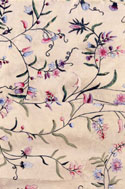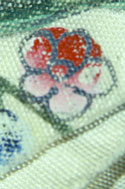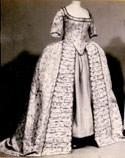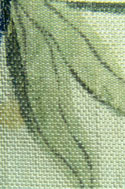Object Studies
Fabric, Painted

What Is This Object?
Painted silk cloth, made into a dress.
1The fabric is a white silk taffeta, hand-painted with a flower, leaf, and trailing-vine pattern.1 Based on the width of the fabric, aspects of the painted design, and evidence of the painting techniques employed, we know that the fabric was woven and painted in China.2
The cut of the dress is typical of a later-eighteenth-century robe à la française: It has a fitted bodice with rounded neckline and short sleeves, a pleated back (not shown), and a wide skirt with an exposed underskirt. (In this image, the underskirt is not original.) The skirt opening is embellished on both sides with a length of the same fabric, box-pleated horizontally; the width of this decoration increases from the waist to the hem. The neckline is also trimmed with narrow (but vertically oriented) box pleats. These fabric insets are then trimmed with a gold-colored silk fringe, here most easily visible at the neckline.
The dress is in the collection of the Philadelphia Museum, a gift of Archibald G. Thomson and Thomas B. Wanamaker Jr. Web Link
^topHow Is Color Created?
| Colors and Color Mixtures | |
|---|---|
| Red | Vermilion, Lac |
| Pink | Vermilion or lac + lead white |
| Green | Malachite or Prussian blue + gamboge |
| Blue | Prussian blue |
| Purple | Prussian blue + lac |
| Light purple | Prussian blue + lac + lead white |
The patterning on this fabric is executed in several shades of red, blue, purple, and green. The pigments were identified as malachite, vermilion, lac, Prussian blue and lead white, all used in an animal-glue binder. Additional lead white was added to certain pigment mixtures to make the light-blue, light-red, and light-purple shades. In contrast the malachite, a medium or jade green, is the lighter of the two greens used here, and the darker green is a combination of Prussian blue and gamboge. The use of two different coloring materials for the green may have been necessary because the mixture of lead white with Prussian blue will turn the color from blue to brown.3 reference The expectation of this color change may also be the reason Reiter and Price noted an unidentifiable substance only in the Prussian blue—perhaps it was a stabilizer.4 reference The proximity of the two green colors throughout the pattern may also explain why the malachite was not given a ground layer of white lead: Even if it was an effort to preserve the colors, the lack of a ground layer to the leaves and trailings gives them a delicate appearance, as it allows the weave of the fabric to show through the color.
5in addition to the coloring materials, the coloring techniques provide evidence for the non-European origin of this fabric. The creation of a hand-painted textile pattern typically required several steps. First, an underdrawing is block-printed onto the fabric to guide the shape and placement of the design elements. Next, a grounding layer of lead white is applied to the areas of the drawing where flowers are depicted. Colors are then added by hand; this creates the calligraphic effect that is typical of designs on eighteenth-century fabrics imported from China. Also typical of Chinese painted silks is a silver outline on the main elements of the design.5
 Compare this technique of embellishing fabric with the preparation of chintz and picture painting, and its pattern with other contemporary designs. Web Link Web Link
Compare this technique of embellishing fabric with the preparation of chintz and picture painting, and its pattern with other contemporary designs. Web Link Web Link
Condition
Alterations to the garment and lack of information about its history before entering the museum collection in 1942 make it difficult to identify specific sources for damage to the fabric, but there are two general types of damage. The pattern is damaged or missing because the cloth was used to make an article of dress, or it was damaged because of the choice of coloring materials or painting techniques. reference The colors are most deteriorated at points where the fabric probably rubbed against itself or other objects, and they are best preserved where stress was the least or the pattern was hidden from the light. Accordingly, the pattern is missing at the shoulders and sides and remains most clear on such elements as the box pleats of the skirt. The silver outlines are tarnished or missing but still visible around the red flower shown here, as a dark-gray outline. Although the condition of the pattern painted on the cloth is uneven, the design is small enough that it remains comprehensible even where colors are completely missing.
The pattern is damaged or missing because the cloth was used to make an article of dress, or it was damaged because of the choice of coloring materials or painting techniques. reference The colors are most deteriorated at points where the fabric probably rubbed against itself or other objects, and they are best preserved where stress was the least or the pattern was hidden from the light. Accordingly, the pattern is missing at the shoulders and sides and remains most clear on such elements as the box pleats of the skirt. The silver outlines are tarnished or missing but still visible around the red flower shown here, as a dark-gray outline. Although the condition of the pattern painted on the cloth is uneven, the design is small enough that it remains comprehensible even where colors are completely missing.
Color change can be seen in the image at the top. It shows two joined sections of the painted fabric; the lower portion is lighter-colored than the upper one. The most significant deterioration includes flaking paint and missing or tarnished silver elements. The latter is a natural and almost unavoidable characteristic of that coloring material; the first two problems are equally predictable outcomes for coloring materials that are not well adhered to the substrate. Reiter and Price note that, overall, the malachite-green elements have retained their color the least well, and they conjecture that this was due to the larger size of the coloring particles needed to create the jade-green shade.6 Problems created by the choice of binder and medium and by the ability of the coloring material to adhere to the substrate are particularly apparent here. The use of thickeners to control capillary action or the application of the lead white ground may have caused the silk fibers to stiffen and the paint layer to flake off. Another possibility is that the ground layer did not adhere sufficiently to the fabric and that its weight simply pulled off the color. The results can be seen in the detailed image of the leaf, where there are small flecks of the darker green within the existing medium-green underlayer, and in the red-colored flower, where a portion of the color is missing.
^topHow Is the Object Used?
This textile has been used to make clothing. Reiter and Price point to evidence in the fabric that suggest the existing dress is an altered or remade version: They note however that there is not enough information to date or document an original style. Reuse of textiles—even when the condition was not pristine—was not unusual for the period or for such garments as this. The original may have been given or sold to someone else. The large quantity of fabric needed to construct this style of garment would facilitate redesign; clever recutting might hide damage to the pattern as it made the object more fashionable. This does suggest that the design remained in fashion—if not at its height—for some time.
10There is no connection between the pattern of the fabric and the construction of the dress, although in a sense the design of the cloth and the details of embellishment are the most important factors that differentiate this object from all other robes à la française of the same period. Painted silk fabrics were a common export item from China to England, which held a monopoly on such goods in the mid-eighteenth century. From England, they were traded throughout the Atlantic world.7 reference Web Link Web Link
^topNotes:
Note 1: Sara Reiter and Beth A. Price, "An Eighteenth-Century Chinese Painted Silk Dress from the Philadelphia Museum of Art: A History of Analysis and Condition," in The Conservation of Eighteenth-Century Painted Silk Dresses, ed. Chris Paulocik and Sean Flaherty (New York, 1995), 21–36. back
Note 2: Leanna-Lee Whitman, "A Curatorial and Scientific Overview of Chinese Eighteenth-Century Silks," in The Conservation of Eighteenth-Century Painted Silk Dresses, 1–5. back
Note 3: Barbara H. Berrie, "Prussian Blue," in Artists' Pigments: A Handbook of Their History and Characteristics, ed. Robert L. Feller, vol. 3, ed. Elisabeth West FitzHugh (Washington, D.C., 1997), 200. back
Note 4: Reiter and Price, "An Eighteenth-Century Chinese Painted Silk Dress," 33. back
Note 5: Whitman, "A Curatorial and Scientific Overview of Chinese Eighteenth-Century Silks." back
Note 6: Reiter and Price, "An Eighteenth-Century Chinese Painted Silk Dress," 22. back
Note 7: Leanna-Lee Whitman and Maruta Skelton, "Where Did All the Silver Go?: Identifying Eighteenth-Century Chinese Painted and Printed Silks," The Textile Museum Journal 22 (1983): 33–52. back



